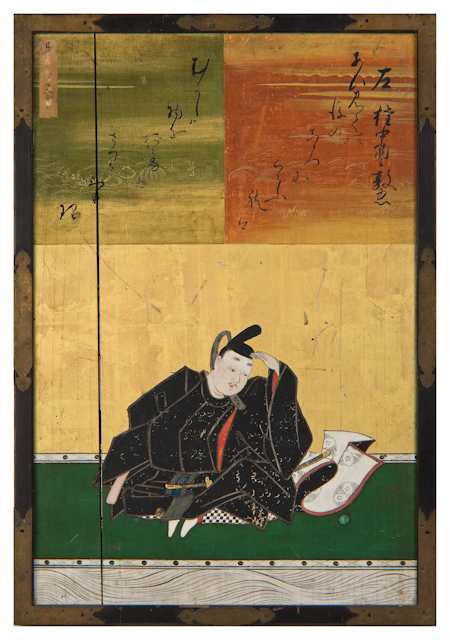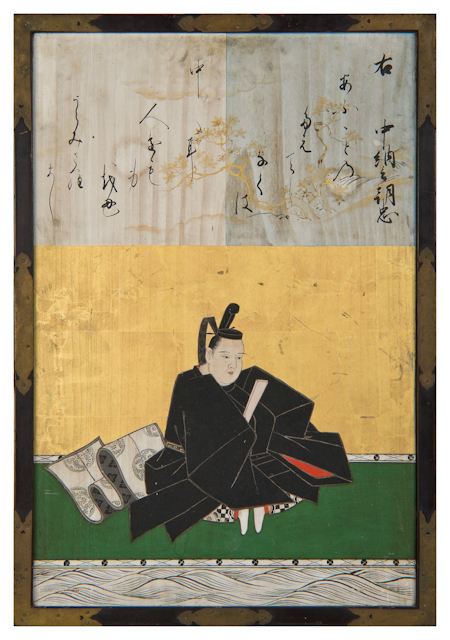|
Thirty-Six Immortals Of Poetry
The are a group of Japanese poets of the Asuka, Nara, and Heian periods selected by Fujiwara no Kintō as exemplars of Japanese poetic ability. The oldest surviving collection of the 36 poets' works is ''Nishi Honganji Sanju-rokunin Kashu'' ("Nishi Honganji 36 poets collection") of 1113. Similar groups of Japanese poets include the Kamakura period ''Nyōbō Sanjūrokkasen'' (女房三十六歌仙), composed by court ladies exclusively, and the , or Thirty-Six Heian-era Immortals of Poetry, selected by (1107–1165). This list superseded an older group called the Six Immortals of Poetry. Sets of portraits (essentially imaginary) of the group were popular in Japanese painting and later woodblock prints, and often hung in temples. Kintō's Thirty-Six Immortals of Poetry # Kakinomoto no Hitomaro # Ki no Tsurayuki # Ōshikōchi Mitsune # Lady Ise # Ōtomo no Yakamochi # Yamabe no Akahito # Ariwara no Narihira # Henjō # Sosei # Ki no Tomonori # Sarumaru no Taifu # ... [...More Info...] [...Related Items...] OR: [Wikipedia] [Google] [Baidu] |
Lady Ise
, also known as , was a Japanese poet in the Imperial court's ''waka'' tradition. She was born to of Ise Province, and eventually became the lover of the and a concubine to Emperor Uda; her son by him was Prince Yuki-Akari.pg 141 of ''Woman poets of Japan'', 1977, Kenneth Rexroth, Ikuko Atsumi, ; previously published as ''The Burning Heart'' by The Seabury Press. Her poems were emblematic of the changing styles of the time, and 22 of them were included in the ''Kokin Wakashū''. One of her poems was included in the ''Ogura Hyakunin Isshu is a classical Japanese anthology of one hundred Japanese ''waka'' by one hundred poets. ''Hyakunin isshu'' can be translated to "one hundred people, one poem ach; it can also refer to the card game of ''uta-garuta'', which uses a deck compos ...''. Poems References External links 870s births 930s deaths Year of birth uncertain Year of death uncertain Kuge 10th-century Japanese women writers 10th-century Jap ... [...More Info...] [...Related Items...] OR: [Wikipedia] [Google] [Baidu] |
Minamoto No Kintada
Minamoto no Kintada (889–948, Japanese: 源 公忠, also 源公忠朝臣 ''Miyamoto no Kintada Ason'') was a middle Heian ''waka'' poet and nobleman. Along with his son Minamoto no Saneakira he is designated a member of the Thirty-six Poetry Immortals. Under Emperor Daigo and Emperor Suzaku he was an official in the imperial treasury. Kintada's poems are included in imperial poetry anthologies from the ''Goshūi Wakashū'' onward. A personal collection known as the '' Kintadashū'' also remains. The '' Great Mirror'' and ''Yamato Monogatari'' preserve anecdotes about him, and he excelled in falconry and kōdō is the art of appreciating Japanese incense, and involves using incense within a structure of codified conduct. ''Kōdō'' includes all aspects of the incense process, from the , to activities such as the incense-comparing games ''kumikō'' () a ..., in addition to poetry. External linksE-text of his poemsin Japanese 889 births 948 deaths Minamoto clan 10th ... [...More Info...] [...Related Items...] OR: [Wikipedia] [Google] [Baidu] |
Fujiwara No Takamitsu
Fujiwara no Takamitsu (藤原 高光, c. 939-994) was a mid-Heian period ''waka'' poet and Japanese nobleman. He is designated as a member of the Thirty-six Poetry Immortals. His father was Fujiwara no Morosuke, and his mother was , the daughter of Emperor Daigo. He was a brilliant waka poet, acclaimed as a genius when he was fifteen, and was included in the Thirty-Six Immortals of Poetry. Takamitsu’s decision to abandon family and social station for life as a Buddhist monk in 961, along with his extended family’s grief over that action, is documented in ''Tōnomine Shōshō Monogatari''. Takamitsu, upon renouncing the world, first lived in “the monastery on Mount Hiei, not far from the capital” but relocated, perhaps as early as 962, “to remote Tōnomine, where he spent the rest of his life, occasioning the name by which he is usually known.”Keene, Donald. ''Travelers of a Hundred Ages''. New York: Columbia University Press, 1999, p 58. Takamitsu's poems are included ... [...More Info...] [...Related Items...] OR: [Wikipedia] [Google] [Baidu] |
Fujiwara No Atsutada
was a mid- Heian ''waka'' and Japanese nobleman. He was designated a member of the Thirty-six Poetry Immortals, and was also known as the and . Poetry Many of Atsutada's poems written in correspondence with court women remain, and some are included in official poetry anthologies such as ''Gosen Wakashū''. One of his poems is included in the famous anthology ''Hyakunin Isshu is a classical Japanese anthology of one hundred Japanese ''waka'' by one hundred poets. ''Hyakunin isshu'' can be translated to "one hundred people, one poem ach; it can also refer to the card game of ''uta-garuta'', which uses a deck compos ...'': External links E-text of his poemsin Japanese 906 births 943 deaths Japanese male poets Fujiwara clan 10th-century Japanese poets Hyakunin Isshu poets {{japan-writer-stub ... [...More Info...] [...Related Items...] OR: [Wikipedia] [Google] [Baidu] |
Fujiwara No Asatada
Fujiwara no Asatada (Japanese: 藤原 朝忠, also 中納言朝忠, ''Chunagon Asatada'') (910 – January 19, 966) was a middle Heian ''waka'' and Japanese nobleman. He was designated a member of the Thirty-six Poetry Immortals and one of his poems is included in the famous anthology ''Hyakunin Isshu''.Asatada's poems are included in official poetry anthologies from the ''Gosen Wakashū The , often abbreviated as ''Gosenshū'' ("Later Collection"), is an imperial anthology of Japanese waka compiled in 951 at the behest of Emperor Murakami by the Five Men of the Pear Chamber: Ōnakatomi no Yoshinobu (922-991), Kiyohara no Motosuke ...'' onward. A personal collection known as the ''Asatadashū'' also remains. External linksE-text of his poemsin Japanese 910 births 966 deaths Japanese male poets Fujiwara clan 10th-century Japanese poets Hyakunin Isshu poets {{japan-writer-stub ... [...More Info...] [...Related Items...] OR: [Wikipedia] [Google] [Baidu] |
Fujiwara No Kanesuke
, also known as the , was a middle Heian-period ''waka'' poet and Japanese nobleman. He is designated as a member of the Thirty-six Poetry Immortals. His great-granddaughter was Murasaki Shikibu, author of the well-known monogatari the ''Tale of Genji''. Poetry Kanesuke's poems are included in several imperial poetry anthologies, including ''Kokin Wakashū'' and ''Gosen Wakashū''. A personal poetry collection known as the ''Kanesuke-shū'' also remains. The ''Tale of Heike'' contains "an almost direct quotation" of his poem in the ''Gosenshū'' (no. 1102). The passage goes, "...as clear as a father's understanding may be in all other matters, love blinds him when it comes to his own child." One of his poems is included in the famous anthology ''Hyakunin Isshu'': See also *''Tsutsumi Chūnagon Monogatari is a post late-Heian period Japanese collection of short stories. Authorship With the exception of one story, the authorship is unknown. It is likely each story was wri ... [...More Info...] [...Related Items...] OR: [Wikipedia] [Google] [Baidu] |
Ono No Komachi
was a Japanese waka poet, one of the ''Rokkasen'' — the six best waka poets of the early Heian period. She was renowned for her unusual beauty, and ''Komachi'' is today a synonym for feminine beauty in Japan. She also counts among the Thirty-six Poetry Immortals. Life Almost nothing of Komachi's life is known for certain, save for the names of various men with whom she engaged in romantic affairs and whose poetry exchanges with her are preserved in the ''Kokin Wakashū''. She was probably born between 820 and 830, and she was most active in composing poetry around the middle of the ninth century. Extensive study has gone into trying to ascertain her place of birth, her family and so on, but without conclusive results. The Edo-period scholar Arai Hakuseki advanced the theory that there was more than one woman named Komachi and that the legends about her referred to different people. This theory was later expanded to conjecture that there were four "Komachis"., citing I ... [...More Info...] [...Related Items...] OR: [Wikipedia] [Google] [Baidu] |
Ki No Tomonori
Ki no Tomonori (紀 友則) (c. 850 – c. 904) was an early Heian ''waka'' poet of the court, a member of the ''sanjūrokkasen'' or Thirty-six Poetry Immortals. He was a compiler of the ''Kokin Wakashū'', though he certainly did not see it to completion as the anthology includes a eulogy to him composed by Ki no Tsurayuki, his cousin and colleague in the compilation effort. Ki no Tomonori is the author of several poems in the ''Kokin Wakashū'', and a few of his poems appear in later official collections. A collection of his poems from various sources appeared as the ''tomonori shū''. Tomonori's most famous ''waka'' is "Hisakata no", included in Hyakunin Isshu that was compiled in the 13th century: Hisakata no (From afar literally, but a pillow word are figures of speech used in Japanese poetry in association with certain words. The set phrase can be thought of as a "pillow" for the noun or verb it describes, although the actual etymology is not fully known. It can also ... [...More Info...] [...Related Items...] OR: [Wikipedia] [Google] [Baidu] |
Sosei
Sosei ( ja, 素性 or 素性法師, 844 – 910) was a Japanese waka poet and Buddhist priest. He is listed as one of the Thirty-six Poetry Immortals, and one of his poems was included in the famous anthology ''Hyakunin Isshu''. His father Henjō was also a waka poet and monk. Sosei entered religious life sometime after his father, who took the tonsure after the death of Emperor Ninmyō was the 54th emperor of Japan, Emperor Ninmyō, Fukakusa Imperial Mausoleum, Imperial Household Agency according to the traditional order of succession. Ninmyō's reign lasted from 833 to 850, during the Heian period. Traditional narrative Nin ... in 850. Waka Poems Sokoi-naki fuchi-yawa-sawagu yamagawa-no asaki-seni-koso adanami-wa-tate (Kokin waka shu) Translation: The deep pools do not have waves, but the shallow rapids of mountain rivers often have waves. Interpretation of love: My deep love for you is unmoved. It is frivolous love that causes rumors. Interpretation of a life lesson ... [...More Info...] [...Related Items...] OR: [Wikipedia] [Google] [Baidu] |
Henjō
, better known as , was Japanese waka poet and Buddhist priest. In the poetry anthology ''Kokin Wakashū'', he is listed as one of the six notable waka poets and one of the thirty-six immortals of poetry. Biography Munesada was the eighth son of Dainagon , who was a son of Emperor Kanmu, relegated to civilian life. He began his career as a courtier, and was later appointed to the position of ' to Emperor Ninmyō. In 849 he was raised to the . After Emperor Nimmyō died in 850, Munesada became a monk due to his grief, taking the religious name ''Henjō'' (literally “Universally Illuminated”). He was a priest of the Tendai school. In 877 Munesada founded in Yamashina, in the southeast part of Kyoto, but continued to be active in court politics. In 869 he was given another temple, , in the north of Kyoto and managed both temples. In 885 he was ranked high priest and was called . He was rumored to have had a love affair with the famous female poet Ono no Komachi. Thirty-fiv ... [...More Info...] [...Related Items...] OR: [Wikipedia] [Google] [Baidu] |




